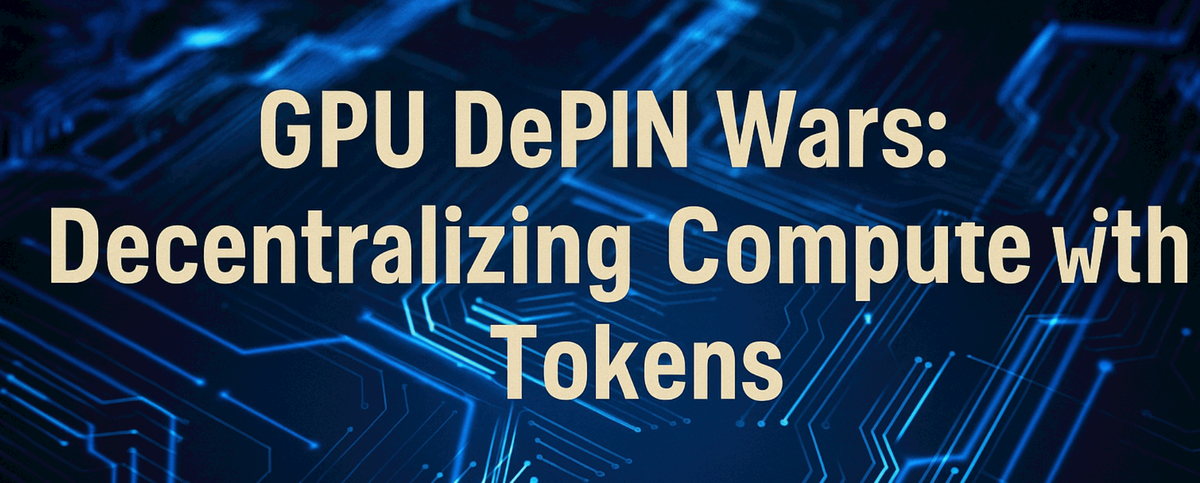GPU DePIN Wars: Decentralizing Compute with Tokens

Introduction: A New War for Compute
In the age of artificial intelligence, deep learning, and immersive Web3 experiences, compute power is the new oil. GPUs, the hardware backbone of modern digital infrastructure, are in more demand than ever, and the traditional cloud players are struggling to keep up. But a new force is emerging: DePIN, or Decentralized Physical Infrastructure Networks. These crypto-powered systems are rewriting the rules of hardware provisioning.
Welcome to the GPU DePIN wars.
Protocols like Render Network, io.net, and OpenGPU are decentralizing access to compute resources by turning idle GPUs around the world into monetizable assets. In the process, they're reshaping how developers access compute and how everyday users can contribute to and profit from the next generation of digital infrastructure.
What Is DePIN?
DePIN refers to blockchain-based protocols that coordinate and monetize real-world infrastructure using decentralized technology. Unlike traditional cloud or utility providers, DePIN networks don't own the physical hardware. Instead, they incentivize individuals and organizations to contribute resources through token rewards.
Whether it's telecommunications (Helium), storage (Filecoin), or energy (Exorde), the DePIN model enables:
- Permissionless participation
- Transparent coordination
- Global access
- Crypto-native monetization
Now, that model is being extended to one of the most valuable resources in tech: GPU compute.
The GPU Bottleneck & The Decentralization Opportunity
AI models like ChatGPT, Stable Diffusion, and Claude require immense GPU power to train and run. Game studios need distributed rendering. ZK-proofs demand intense parallel computation. Yet, centralized providers like AWS, Azure, and GCP are:
- Expensive
- Limited in availability
- Heavily gatekept
Meanwhile, millions of GPUs sit underutilized in gaming rigs, crypto mining farms, and edge data centers. GPU DePIN protocols aim to connect these idle resources with real-world demand.
This is not just about making GPUs available. It’s about reclaiming compute as a public good, powered by market incentives and cryptographic trust.
The Key Players in GPU DePIN
Render Network (RNDR)
- Use Case: Decentralized rendering for 3D, AR/VR, and digital art
- How It Works: Artists upload rendering jobs to a decentralized network of GPU providers using OctaneRender
- Token Utility: $RNDR is used for payments, staking, and governance
- Adoption: Used by major artists and digital studios; integrated with Apple Vision Pro workflows
io.net
- Use Case: Decentralized compute for AI model training and inference
- How It Works: Aggregates thousands of GPU nodes across Solana, with fast finality for coordination
- Token Model: $ION used for incentives and coordination; penalties for bad actors
- Momentum: A leading AI DePIN narrative with support from Solana and growing developer interest
OpenGPU
- Use Case: General-purpose decentralized compute for AI, Web3, and ZK applications
- Architecture:
- EVM-compatible multi-layer architecture
- On-chain validator model for GPU verification
- Devnet environment for AI/ML experiments
- Unique Features:
- Sustainability focus (optimize underutilized compute)
- oGPU tokens used for usage, staking, and validation rewards
- Vision for cross-industry DePIN integration
GPU DePIN Ecosystem Map
This Map visualizes how decentralized compute protocols like Render, io.net, and OpenGPU orchestrate a global, token-incentivized network of GPU power.

Tokenomics & Incentive Mechanics
Each protocol uses tokens to solve the classic coordination challenge:
- Node Operators: Contribute GPU power in exchange for rewards
- Users: Pay in protocol tokens to access the compute
- Stakers: Secure the network and validate jobs
| Stakeholders | Action | Incentive Mechanism |
|---|---|---|
| GPU Providers | Offer compute power | Earn tokens per usage |
| Developers/Users | Rent compute | Pay with tokens |
| Validators | Verify compute output | Get rewards, avoid slashing |
| Token Holders | Govern protocol | Influence fees, policy |
This decentralized marketplace model transforms idle GPU power into an on-chain productive asset.
Real-World Use Cases
- AI-as-a-Service: Developers renting decentralized inference servers
- ZK-Proving-as-a-Service: Generating zero-knowledge proofs on-chain via GPU networks
- Render Farms: Visual effects artists and 3D creators accessing affordable distributed rendering
- DePIN-Native Gaming: Games using player-run compute networks for AI NPCs and immersive visuals
Challenges Ahead
While the vision is massive, GPU DePIN protocols must solve real-world challenges:
- Reliability: Ensuring GPU uptime, performance, and job completion integrity
- Security: Preventing misuse, data leakage, or tampering with tasks
- Hardware Verification: Validating that node operators own the claimed GPU resources
- Legal Risk: Navigating international laws around data, compute, and crypto payments
- Adoption Gap: Competing with the convenience of Amazon and Google
Still, early adoption curves show promise, especially among AI startups, DAOs, and DeFi-native developers.
The Future of GPU DePIN
As DePIN matures, GPU-based networks could:
- Interoperate through shared registries and identity layers
- Form federations or alliances to create DePIN cartels
- Spawn tokenized compute futures, derivatives, and credit markets
- Power AI agents, Web3 apps, and even DeSci labs on fully decentralized stacks
Imagine your idle GPU at home earning passive income, participating in AI model inference for climate simulations, and helping power a game on another continent, all coordinated by smart contracts.
Conclusion: The Edge Has Gone On-Chain
The GPU DePIN wars are more than a trend; they’re the reimagining of who owns and monetizes compute. Rather than relying on a few cloud monopolies, we’re building a global, trustless network where compute is liquid, programmable, and publicly accessible.
With the rise of protocols like Render, io.net, and OpenGPU, the edge has truly gone on-chain. And in the coming years, decentralized compute could become the most important utility of the internet.


Comments ()